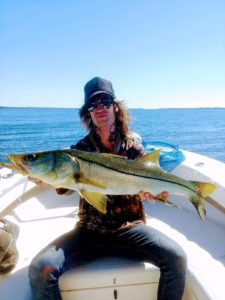All About Inshore Saltwater Fishing
What is inshore saltwater fishing and how is it different from offshore fishing?
The primary difference between Inshore and Offshore or “deep sea” fishing is the location. Inshore charters are primarily located inside the barrier islands and within protected waters or bays. Offshore fishing is when you exit the barrier islands and head out to sea beyond the to fish. Offshore fishing can be further divided into near-shore and “real” offshore based on the state border. Where I am located on the Gulf Coast of Florida that is 9 miles from the shoreline but on the atlantic coast it is only 3 miles. The only difference between nearshore and offshore is for legalities which I will get to on another page.
Inshore saltwater fishing involves fishing for a wide variety of species such as redfish, snook, pompano, spotted sea trout, tarpon, grouper, mackerel, mangrove snapper, and flounder, to name a few. This type of fishing is done from the edge of beaches, island shorelines, fishing peers and places that are easily accessed by small boats such as bay boats, flats boats or even a kayak, canoe. There are many places to look for fish while you are inshore fishing a few are inlets, mangrove tree lines, sandbars, oyster bars, docks and other man-made cover. When fishing offshore or anglers rely on sonar to locate the structure or depth changes which commonly hold fish.
When you go saltwater fishing you will need to have the right equipment to ensure a successful trip. Saltwater is a very rough environment for anything that comes in contact with it, therefore you need to make sure your gear is designed for use in it. When looking for the right kind of gear for inshore fishing it is just like any other market. When looking at tackle such as rods and reels there are many different levels of quality from inexpensive “cheap” and often poorly made to expensive “boutique” very high quality. I usually recommend that you first look at the type of fish and location you intend to fish before you start shopping for gear. Too heavy of gear can be cumbersome and heavy to hold all day but too light can extend a fight and exhaust a fish to death. For the smaller inshore species such as Sea trout and mangrove snapper a 2500 series reel on a lighter medium action 8-15lb rod around 7ft is a great choice. For bigger snook and reds you would want to lean towards a bigger reel something lik e a 4000 or maybe even 5000 series reel on a 12 to 25lb rod as these fish can be quite powerful. In a perfect world we would each have hundreds of different rod and reel setups for each individual species and scenario for most of us we have to settle for a kinda do all rig. For that do all general inshore fishing rig start with a 3000 to 4000 size spinning reel spooled up with 15 to 20 pound line then mount that on a 7 foot medium heavy action rod rated around 10-20lbs. This will work in just about every situation when targeting snook, trout, and redfish. For really large fish such as Tarpon, a specific rod and reel setup is most definitely recommended such as a 6500-8000 size reel mounted on a stout 7 foot 6 inch 15-40 pound
e a 4000 or maybe even 5000 series reel on a 12 to 25lb rod as these fish can be quite powerful. In a perfect world we would each have hundreds of different rod and reel setups for each individual species and scenario for most of us we have to settle for a kinda do all rig. For that do all general inshore fishing rig start with a 3000 to 4000 size spinning reel spooled up with 15 to 20 pound line then mount that on a 7 foot medium heavy action rod rated around 10-20lbs. This will work in just about every situation when targeting snook, trout, and redfish. For really large fish such as Tarpon, a specific rod and reel setup is most definitely recommended such as a 6500-8000 size reel mounted on a stout 7 foot 6 inch 15-40 pound


